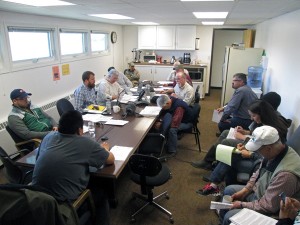On the day that the summer’s king salmon restrictions began, the Kuskokwim River Salmon Management Working Group met to hash out the details of this summer fishing plans. Managing a precarious king salmon run along 700 miles of river will be anything but simple.
After months of in depth discussions leading up to the closures, 12 hours in, some working group members were still confused.

“What about now, is it wide open it now to any type of gear, or drifting or what? That’s the confusion we have,” said Aloysius..
Bob Aloysius is from Kalskag. Part of that confusion come from the different geographic jurisdictions. Federal managers control the waters in the Yukon Delta National Wildlife Refuge from the mouth to Aniak. The state manages below the mouth and above Aniak.
There are a few key differences in regulations, especially around the middle river. Unlike the federal rules, the state would allow drifting with 4” nets. And they do not plan to allow fishwheels above Tuluksak during times of king salmon conservation, whereas the feds would with certain protections for kings. That comes as bad timing to several Middle River villages which, through the Kuskokwim Native Association, are investing in fish wheels. Lisa Feyereisen is from Chuathbaluk.
“It absolutely does not make sense that we could sit out there drifting with 4” mesh and keep incidental kings when we’re more than willing, we’ve purchased the material, we have people monitoring the fish wheel, and we’re releasing every single king, and that’s the goal of it, to release every single king,” said Feyereisen.
Chuathlbaluk was hoping to have a fish wheel running for the first time in 25 years. The working group passed a motion in support of allowing fish wheels on state waters. As it stands in the management plan, fishwheels operations are linked with 6” mesh openings, which would only be done when there are very few kings in the river.
Federal in Season Manager Brian McCaffery shared details on what’s hoped to be a small social and cultural harvest opportunity of about 1,000 kings total. He says it would be on a per capita basis for 31 of the 32 eligible communities. Each village get a dozen to several dozen fish, but Bethel would not be not proportional to population and may receive around 100 kings.
“Our primary goal again this year is conservation. And we want to give people an opportunity, we hope to work with the tribal council here in Bethel to find ways to provide community opportunities,” said McCaffery.
But the run has to be strong enough to support that limited harvest. To gauge that and considering this year’s early breakup, the Bethel Test Fishery will be starting a few days early, around the 27th.
And just days before the run hits in earnest, managers are worried about two weirs that are hanging in balance. The villages of Tuluksak, Kwethluk, Akiak, and Akiachak signed a letter saying that that if they can’t fish for kings for sometime in June, Tuluksak and Kwethluk would break contracts for operating the Tuluksak and Kwethluk river weirs. Steve Miller is with the U.S. Fish and Wildlife Service.
“But we’re hoping right now we can resolve that and get a contract in place. We’re required by law to conserve the fish on this river. That takes data, and those two systems are the only two systems on the lower river and our plan is to operate both weirs,” said Miller.
The group passed a motion supporting the operation of all the river’s weirs to count escapement. The next working group meeting will be at call of chairs.
Ben Matheson is a contributor with the Alaska Public Radio Network.




